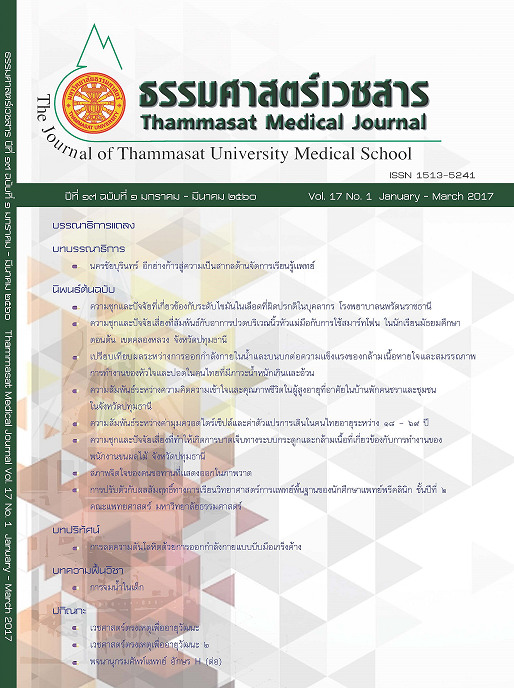Mentality of Thai beggars portrayed in drawings
Keywords:
Free drawing, Mentality, Beggars, Symbolic images, ภาพวาดอิสระ, อัตลักษณ์สภาพจิตใจ, คนขอทาน, สัญลักษณ์ภาพAbstract
Introduction: Beggars are globally visible among the low-class populace, especially in underdeveloped and developing countries; however, it is not entirely true that all of them are from the lower classes of society, since a few of them have been found to be quite rich and educated. Currently, the reasons for begging have changed over those in the past, as a good number of beggars are hired for their performance. However, the phenomenon of begging reflects a complex issue of social inequality that needs to be addressed. The objective of this study was to identify reasons for begging, assessed from the mental expression of beggars through their symbolic images.
Method: In May and July 2016, the investigation was carried out among Thai beggars at random locations in the streets of Bangkok and nearby provinces; the beggars were persuaded to draw freely anything they wished on a sheet of white paper using pencils. The drawings were subsequently analyzed in order to assess the mental expression of the beggars in the context of symbolic images.
Result: Off the 30 subjects (15 men and 15 women), their drawings showed mental expression focused on their upbringing, environments and familiar things from the past, such as images of events and persons that they had earlier encountered. Absent from their drawings were symbolic images that expressed motivation and perceptions of life values. Female beggars tended to have a little higher ambition and motivation than males.
Discussion and Conclusion: The apparently weakened and incompetent lines and compositions of their drawings reflected their lack of motivation, hope and self-esteem; however, these aspects might have been related also to their levels of education. From the findings of the present study, it may be concluded that the symbolic images expressed in the free drawings of the beggars in the study reflected to a certain extent the mentality, inner thoughts and feelings, and past experiences, which revealed their attraction to begging.
บทนำ: สัญลักษณ์ภาพถ่ายทอดประสบการณ์ในอดีตที่เป็นสิ่งใกล้ตัวที่คุ้นเคย และสภาพธรรมชาติแวดล้อม การวิเคราะห์สัญลักษณ์ในภาพวาดเป็นวิธีศิลปกรรมที่มีประสิทธิภาพในการประเมินสภาพจิตใจบุคคล วัตถุประสงค์ของการศึกษานี้เพื่อค้นหาอัตลักษณ์สภาพจิตใจของคนขอทานที่แสดงออกในภาพวาด
วิธีการศึกษา: ในช่วงเดือนพฤษภาคมถึงเดือนกรกฎาคม พ.ศ. ๒๕๕๙ ให้คนขอทานในเขตกรุงเทพมหานคร และปริมณฑล ได้แก่ จังหวัดนนทบุรีและจังหวัดสมุทรปราการ ๓๐ คนวาดภาพอิสระในกรอบเวลาครั้งละไม่เกิน ๖๐ นาที แล้วนำภาพมาวิเคราะห์การแสดงออกเชิงสัญลักษณ์ร่วมกับข้อมูลทั่วไป
ผลการศึกษา: การวิเคราะห์ภาพวาดของคนขอทานแสดงภาวะด้อยศักยภาพทางศิลปะและความคิด ไม่แสดงสีสรรและรูปร่างที่สมบูรณ์แสดงว่าขาดความมั่นใจบ่งบอกระดับจิตด้อยสภาพในด้านแรงจูงใจในชีวิตและการเห็นคุณค่าตนเองที่สะท้อนถึงปัญหาด้านการรับรู้คุณค่าต่อชีวิตและสังคมที่ขาดความมุ่งหวัง เป็นข้อมูลส่วนบุคคลในด้านการพัฒนาทั้งในด้านการศึกษาและความยากจน ที่เป็นปัญหาชักนำอาชีพขอทาน ผู้หญิงมีอัตลักษณ์สภาพจิตใจที่มีแรงจูงใจความปรารถนาและมุ่งหวังสูงกว่าเพศชาย
วิจารณ์ และสรุปผลการศึกษา: อัตลักษณ์สภาพจิตใจของคนขอทานพบว่าด้อยศักยภาพและด้อยโอกาสทางสังคมจากด้อยการพัฒนาคุณภาพชีวิตพื้นฐานสอดคล้องกับข้อมูลด้านปัจจัยส่วนบุคคล ผลการศึกษายืนยันว่ากิจกรรมวาดภาพอิสระสามารถแสดงจิตใต้สำนึกเชิงสัญลักษณ์ภาพ สอดคล้องกับแนวคิดของ Margaret Naumburg



